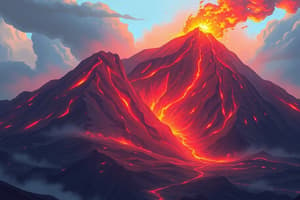Podcast
Questions and Answers
What is a primary characteristic of tropical cyclones?
What is a primary characteristic of tropical cyclones?
Which of the following is NOT typically affected by natural hazards?
Which of the following is NOT typically affected by natural hazards?
At what point in the year is the frequency of tropical cyclones generally at its highest?
At what point in the year is the frequency of tropical cyclones generally at its highest?
What resources are commonly disrupted during significant natural hazards?
What resources are commonly disrupted during significant natural hazards?
Signup and view all the answers
What type of areas are typically most vulnerable to the effects of tropical cyclones?
What type of areas are typically most vulnerable to the effects of tropical cyclones?
Signup and view all the answers
Flashcards
Tropical cyclone
Tropical cyclone
A strong storm system that forms over warm ocean waters.
Residential land use
Residential land use
Areas designated for homes and residential purposes
Industrial land use
Industrial land use
Areas where commercial or industrial activities take place.
No power supply
No power supply
Signup and view all the flashcards
No water supply
No water supply
Signup and view all the flashcards
Study Notes
Major Natural Hazards
- Natural hazards are events like tropical cyclones, landslides, and earthquakes that threaten human life and property.
- Natural events that do not affect human society are not considered hazards.
Types of Natural Hazards
- Earthquake
- Volcanic eruption
- Landslide
- Tropical cyclone
- Flooding
- Drought
Natural Hazard Distribution
- Some hazards, like landslides and flooding, occur globally.
- Others, like tropical cyclones and earthquakes, are specific to certain locations.
- Europe is threatened by earthquakes, flooding, and droughts.
- Southeast Asia faces earthquakes, volcanic eruptions, flooding, droughts.
- Africa is affected by volcanic eruptions, earthquakes, and flooding.
- Hong Kong is affected by earthquakes, flooding, and tropical cyclones.
Weather Elements
- Temperature: Measured in degrees Celsius (°C)
- Precipitation: Rain, snow, hail, measured in millimeters (mm)
- Air pressure: Weight of air pressing down, measured in hectopascals (hPa)
- Wind: Direction and speed, measured in metres per second (m/s)
- Relative humidity: Amount of water vapor in the air, expressed as a percentage (%)
- Cloud amount: Fraction of the sky covered by clouds, expressed as a percentage (%)
Weather Chart
- A weather chart uses symbols to display weather elements for a specific time and area.
- The numbers on the chart represent temperatures.
- Red symbols signify precipitation types.
- Arrows represent wind, with direction and speed indicated.
Climate
- Climate is the average weather conditions over a long period (typically 30 years).
- Hong Kong has a hot, wet summer and a cool, dry winter.
- Approximately 80% of the total rainfall occurs between May and September.
- Hong Kong's climate is significantly influenced by the monsoon system, with seasonal wind shifts.
Monsoon System
- The monsoon system refers to seasonal shifts in wind direction in South Asia.
- Summer monsoons blow from the ocean to the land (onshore) bringing moisture and rain.
- Winter monsoons blow from the land to the ocean (offshore) bringing dry air.
Tropical Cyclones
- Tropical cyclones (also known as typhoons) are low-pressure systems that form over warm tropical oceans.
- They require ocean surface temperatures of at least 26°C for formation.
- Regions over the western Pacific Ocean are where tropical cyclones that affect Hong Kong develop.
- The cyclones often move northwest toward South China or other parts of East Asia.
- Tropical cyclones bring strong winds, heavy rain, and storm surges to coastal areas.
Impacts of Tropical Cyclones in Hong Kong
- Social impacts: Coastal flooding, landslides, damage to infrastructure like pavements, recreational facilities, and shopping malls.
- Traffic disruption: Blocked roads, uprooted trees, and disruption to bus and railway services.
- Power and water supply disruption: Impacts on households and businesses.
- Casualties: Injuries and deaths due to falling objects, flooding, and other hazards.
- Economic impacts: Loss of productivity, property damage, and high repair costs.
Hong Kong's Preparedness for Tropical Cyclones
- Monitoring and forecasting: Utilizing satellites and radar technologies to track tropical cyclone development and movement.
- Warning signals: Issued by the Hong Kong Observatory to alert the public.
- Emergency response plans: Implementing inter-departmental collaboration and drills to manage and mitigate disaster effects.
- Education and awareness: Raising public awareness on typhoon preparedness and safety.
- Emergency relief: Organizing rescue teams and setting up temporary shelters.
- Cleaning affected areas: Restoring essential services and facilities.
Studying That Suits You
Use AI to generate personalized quizzes and flashcards to suit your learning preferences.
Related Documents
Description
Explore the critical aspects of natural hazards, including types like earthquakes, tropical cyclones, and landslides. Learn about their global distribution and the specific threats they pose to different regions. This quiz will enhance your understanding of how these events impact human life and property.




